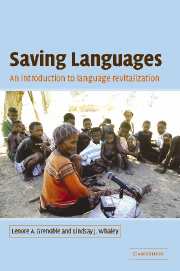7 - Creating a language program
Published online by Cambridge University Press: 04 December 2009
Summary
This chapter provides a step-by-step account of how a community interested in revitalizing a language can assess its needs, commitment, resources, and goals, and then, based on these factors, how they can go about establishing the appropriate language program.
Preliminaries
Before beginning a revitalization program, we recommend as full an assessment as possible of resources available for the program, the status of the language, numbers of speakers, levels of knowledge of the language, levels of multilingualism, literacy, and so on. It should also cover an evaluation of community support, goals, and values, and the relationship with government agencies, including possible sources of financial support and relevant legislation. We recognize that a thorough assessment may take years to complete, and therefore may not be feasible in many cases of language revitalization, but some sort of preliminary assessment is needed in every community.
Assessment of resources
In the initial planning stages of any language revitalization program, it is important to identify the resources available to the program. In order to write about them more clearly, we have divided them into three categories: (1) financial resources; (2) language resources; and (3) human or emotional resources. By financial resources we mean the sources of money available within the community, the likelihood of obtaining external funding (from the federal government or humanitarian organizations, for example), as well as the kinds of resources available for education and programming, the use of media, etc. Language resources include access to existing language materials, such as grammatical descriptions and dictionaries, textbooks, pedagogical materials, written and oral literatures, and so on.
Information
- Type
- Chapter
- Information
- Saving LanguagesAn Introduction to Language Revitalization, pp. 160 - 204Publisher: Cambridge University PressPrint publication year: 2005
